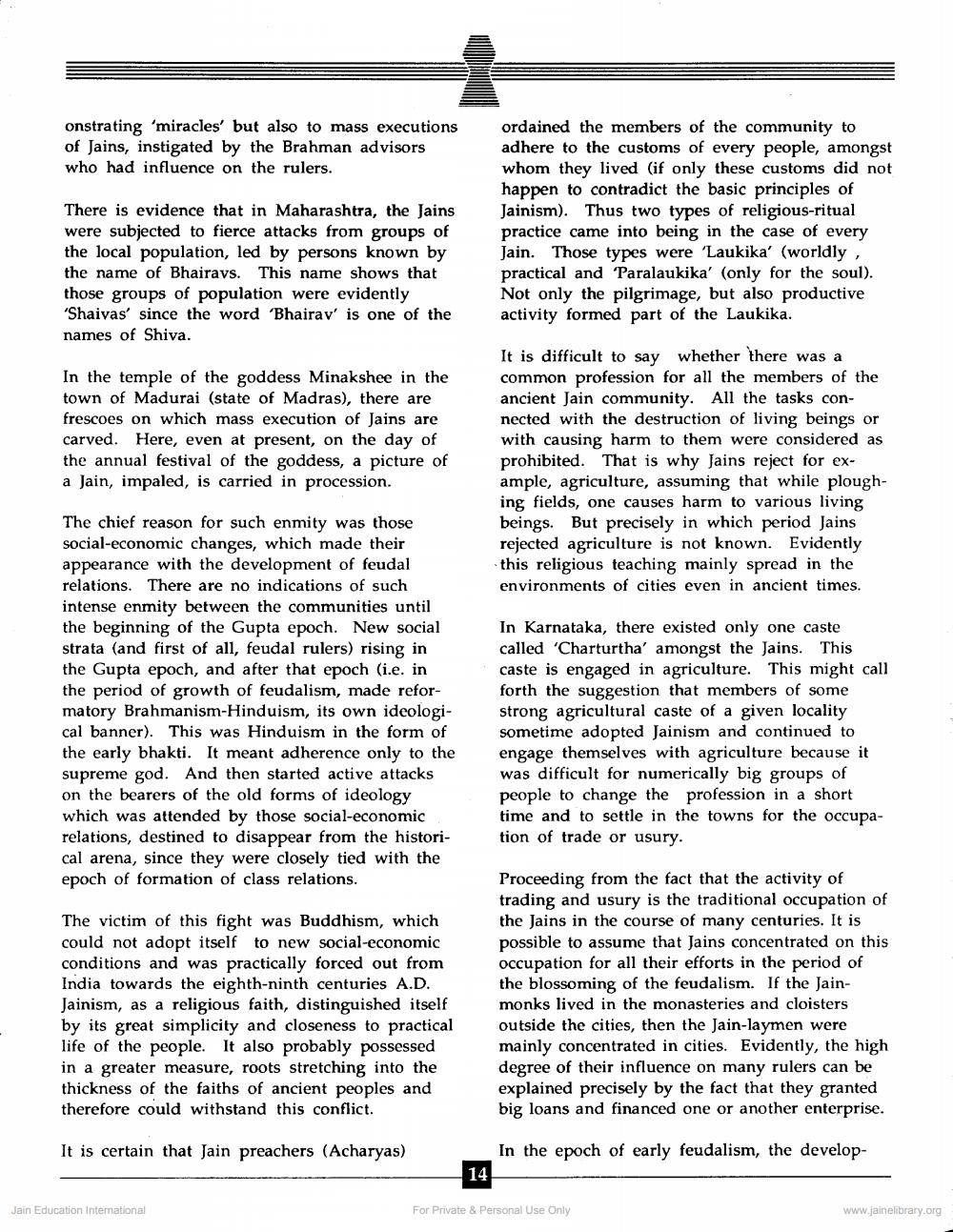________________
onstrating 'miracles' but also to mass executions of Jains, instigated by the Brahman advisors who had influence on the rulers.
There is evidence that in Maharashtra, the Jains were subjected to fierce attacks from groups of the local population, led by persons known by the name of Bhairavs. This name shows that those groups of population were evidently Shaivas since the word "Bhairav' is one of the names of Shiva.
ordained the members of the community to adhere to the customs of every people, amongst whom they lived (if only these customs did not happen to contradict the basic principles of Jainism). Thus two types of religious-ritual practice came into being in the case of every Jain. Those types were 'Laukika' (worldly, practical and Paralaukika' (only for the soul). Not only the pilgrimage, but also productive activity formed part of the Laukika.
In the temple of the goddess Minakshee in the town of Madurai (state of Madras), there are frescoes on which mass execution of Jains are carved. Here, even at present, on the day of the annual festival of the goddess, a picture of a Jain, impaled, is carried in procession.
It is difficult to say whether there was a common profession for all the members of the ancient Jain community. All the tasks connected with the destruction of living beings or with causing harm to them were considered as prohibited. That is why Jains reject for example, agriculture, assuming that while ploughing fields, one causes harm to various living beings. But precisely in which period Jains rejected agriculture is not known. Evidently this religious teaching mainly spread in the environments of cities even in ancient times.
The chief reason for such enmity was those social-economic changes, which made their appearance with the development of feudal relations. There are no indications of such intense enmity between the communities until the beginning of the Gupta epoch. New social strata (and first of all, feudal rulers) rising in the Gupta epoch, and after that epoch (i.e. in the period of growth of feudalism, made reformatory Brahmanism-Hinduism, its own ideological banner). This was Hinduism in the form of the early bhakti. It meant adherence only to the supreme god. And then started active attacks on the bearers of the old forms of ideology which was attended by those social-economic relations, destined to disappear from the historical arena, since they were closely tied with the epoch of formation of class relations.
In Karnataka, there existed only one caste called 'Charturtha' amongst the Jains. This caste is engaged in agriculture. This might call forth the suggestion that members of some strong agricultural caste of a given locality sometime adopted Jainism and continued to engage themselves with agriculture because it was difficult for numerically big groups of people to change the profession in a short time and to settle in the towns for the occupation of trade or usury.
The victim of this fight was Buddhism, which could not adopt itself to new social-economic conditions and was practically forced out from India towards the eighth-ninth centuries A.D. Jainism, as a religious faith, distinguished itself by its great simplicity and closeness to practical life of the people. It also probably possessed in a greater measure, roots stretching into the thickness of the faiths of ancient peoples and therefore could withstand this conflict.
Proceeding from the fact that the activity of trading and usury is the traditional occupation of the Jains in the course of many centuries. It is possible to assume that Jains concentrated on this occupation for all their efforts in the period of the blossoming of the feudalism. If the Jainmonks lived in the monasteries and cloisters outside the cities, then the Jain-laymen were mainly concentrated in cities. Evidently, the high degree of their influence on many rulers can be explained precisely by the fact that they granted big loans and financed one or another enterprise.
It is certain that Jain preachers (Acharyas)
In the epoch of early feudalism, the develop
Jain Education Intemational
For Private & Personal Use Only
www.jainelibrary.org




